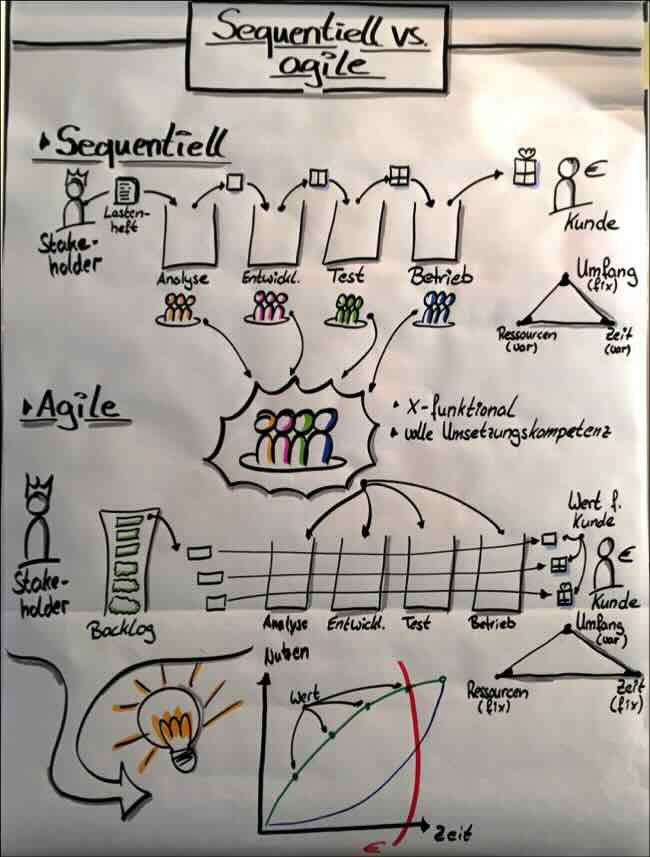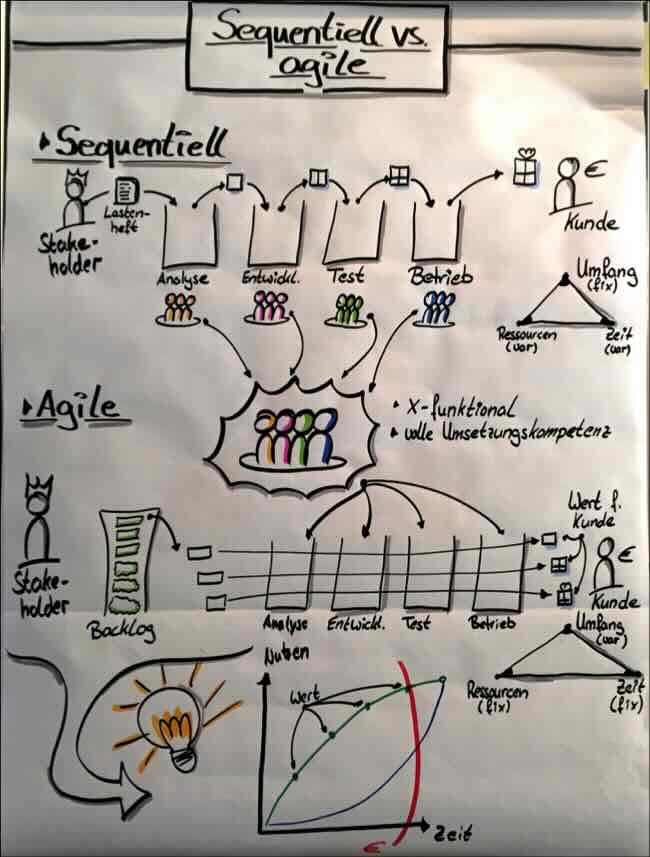What can I say about the flipchart?
The following narrative relates primarily to complex projects, such as product development projects (software, hardware, etc.).
Sequential
Sequential methods are usually expressed by silos in which specialists are organized in order to process large piles of work as efficiently as possible. The silos are organized along a process that results in a product that is intended to provide added value for a customer. The trigger is usually an order from a stakeholder, which starts with a specification sheet containing a collection of all the requirements for the future product. This specification describes this large pile of work and represents an initial major risk for complex projects for various reasons:
- Statistics show that at the end of a complex project, it turns out that up to 50% of the requirements were not met. This means that what is required at the beginning does not correspond to what the customer wants. This in turn results in requests for changes. The specifications at the beginning can therefore be described as very vague.
- A specification sheet does not usually prioritize features, as the complete implementation of a specification sheet is generally commissioned. This means that the most important feature of a product is therefore delivered at the same time as the least important.
- Sequential projects are plan-driven. For this reason, a specification sheet is specified right at the beginning in order to have a basis for planning. Due to its vagueness, this represents a significant waste, as there will be a corresponding need for change for 50% of the requirements on a statistical average.
Due to the division of labour in silos, only one group of specialists at a time looks at the input available at that point in time with the aim of generating a corresponding output for the next silo or, ultimately, for the customer. This also harbors a number of risks:
- The focus on added value for the customer is lost.
- Customer feedback is not "built in" to this procedure and therefore only follows at the end when the product has been completed and delivered in accordance with the specifications.
- The most creative solutions arise when people with different backgrounds look at a problem and do so continuously. This is hardly possible in an organization based on the division of labour in silos.
- The processing of large batches in particular produces extensive interim results that do not deliver any value from the customer's perspective, but rather represent a translation service for the next silo.
- On the one hand, these interim results lead to a loss of creative output because preliminary work restricts the view, as too many specifications are made, and on the other hand, there is a high communication effort.
The underlying attitude in sequential procedures is plan-driven. This means that there is a fixed scope that a variable amount of resources (usually people) are to implement in a variable amount of time. The basic problem with this approach to complex projects is above all the great vagueness of the scope to be delivered, on which the planning is based. The following conclusion can therefore be drawn in favor of a sequential approach:
- A specification sheet is not prioritized in terms of value and is already very detailed at a very early stage due to the plan-driven approach. This poses a serious risk in connection with the high level of imprecision.
- The division of labor prevents the joint evaluation of a problem or issue, which has been proven to lead to more creative solutions.
- The transfer of extensive interim results to silo boundaries leads to a high level of communication and change effort. In addition, these interim results do not represent any added value from the customer's perspective.
- Sequential procedures follow a plan that is based on a very fuzzy scope in complex environments. Attempts are made to counteract the possible consequences by adding resources or adjusting time. However, additional resources reduce performance, especially at the beginning (Tuckman, increasing communication effort, familiarization, etc.). Postponing release dates can lead to contractual penalties, loss of reputation or similar.
Agile
The agile approach differs fundamentally from the sequential approach described above when dealing with the challenges of complex projects. The first difference can be seen in the way requirements are handled. In the agile world, requirements are managed through entries in a so-called Backlog organized. A backlog should follow the DEEP acronym:
- Detailedappropriately: appropriately detailed. The closer the implementation of an entry comes, the more detailed the entry should be. Experience shows that 1-2 development cycles (sprints in Scrum) in advance are appropriate here.
- Emergent: The backlog is not cast in stone, but is continuously developed on the basis of experience and feedback.
- Estimated: Entries in the backlog are estimated. The further away the entry is from implementation, the coarser the estimate. Precise and detailed planning or estimation in advance is deliberately avoided (just-in-time concept).
- Prioritized: The entries follow a strict sequence.
Another key difference is the way in which the requirements are implemented. This is not done once on the basis of a large batch, but continuously in small units. Starting from "The New New Product Development Game", the specialists responsible for the product are organized in cross-functional and self-organized teams. Care is taken to ensure that the team combines all the skills required for implementation. This team works together on a daily basis, ideally on site, to translate the requirements into an appropriate product. Product increment which should represent value from the customer's perspective. The basic attitude on which an agile approach is based is value-driven. The resources (e.g. team) and time (e.g. project duration) are fixed and the scope is variable. There is always a commitment to work on the highest priority requirements.
The final diagram on the flipchart illustrates the desire to deliver real customer benefits and receive feedback as early as possible. This means that at the end of the project, if not everything has been realized, only the supposedly least important things remain.



Write a comment